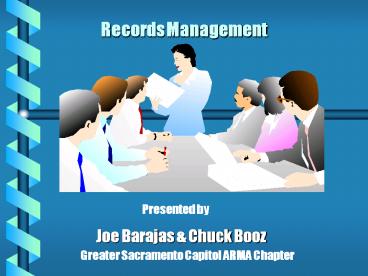Records Management - PowerPoint PPT Presentation
1 / 24
Title:
Records Management
Description:
... Public Records Act. Gov Code Sect. 6250-6261 As a general rule all public ... Public records-writing containing information related to the conduct of the ... – PowerPoint PPT presentation
Number of Views:1088
Avg rating:3.0/5.0
Title: Records Management
1
Records Management
Presented by
- Joe Barajas Chuck Booz
Greater Sacramento Capitol ARMA Chapter
2
Issues
- Strategic Records Planning
- Enterprise Records Knowledge
- Records Standards
- Records Appraisal
- Record Lifecycle/Continuum
3
Important Concerns?
- The importance of Records Management
- Records Retention
- Operations/use of a Records Center
- Role of Standards
4
What is Records Management?
- Records Management is designed to ...apply
efficient and economical management methods to
the creation, utilization, maintenance,
retention, preservation, and disposition of
records.
5
Do you know?
- How many records you have and where they are
kept? - Who uses the records and how often are they used?
- When the last review was done to see if retention
periods could be shortened?
6
Reasons for Records Management
- Control the creation and growth of records
- Minimize litigation risks
- Safeguard Vital information
- Preservation of historical documents
Save Space
Save Time
Save Money
7
Establishing a Program
- If Records Management is to be successful,
top management must be aware of the statutory
requirement, understand the importance of it,
and fully support the program
8
Records Management Analyst
- In order to ensure that responsibility be
assigned at a level within the agency that has
easy access to management and all divisions,
agencies must employ an analyst
9
What are Records?
- Paper, map exhibits
- Magnetic or paper tapes
- Microfilm, photographic films prints
- Other documents produced, received, owned or used
regardless of physical form or characteristics.
10
What are Non-records?
- Transmittal letters and acknowledgements
- Informal notes, worksheets, rough drafts of
letters, memos, reports that do not represent
basic steps in preparing documents - Shorthand notes, stenographic notebooks,
stenotype tapes, and dictating media which have
been transcribed - Miscellaneous notices regarding community
affairs, employee meetings, or holidays
11
Non-records
- Stocks of publication or unused forms that are
kept for supply purposes only - Requests for printed material after the requests
have been filled - Tickler, follow-up or suspense copies of
correspondence - Library and reference material
12
Steps in a Records Retention Program
- Take an inventory
- Appraise all records
- Establish retention periods
- Develop retention schedules
- Approve retention schedules
- Apply retention schedules
13
Preparing for the Records Inventory
- Find out what records there are and where they
are stored? - Figure from the table of measurements the
quantity in cubic feet - When should it start and be completed
- What information will be obtained concerning each
group of records.
14
Appraising the Record
- Values to be considered
- Administrative
- Legal
- Fiscal
- Research, Historical or Archival
15
Administrative Value-created to help accomplish
the functions for which an agency is responsible
- Examples include
- General Correspondence, chron/reading files,
policies, procedures, org charts, directives - Property /Facilities
- Records Management
16
Legal Value- contains evidence of legally
enforceable right or obligations.
- Examples include
- Legal decisions opinions
- Fiscal documents representing agreements, such as
leases, titles, contracts - Records of action in particular cases, such as
claim papers and legal documents
17
Fiscal Value- those records which pertain to the
financial transactions.
- Budgets
- Ledgers
- Allotments
- Payrolls and vouchers
18
Research, Historical or Archival Value-documents
the departments accomplishments.
- Minutes of Board Meetings
- Letters signed by nationally known figures such
as politicians or scientists - Typically apply only to about 5 of your records
19
Setting Retention Periods
- Negotiate the retention periods internally
- Review CAM for the General retention periods for
personnel, fiscal, and payroll records - Consult with managers and users
- Federal and State Statutes
- Perpetual type record
20
Perpetual Type Records
- Current- indicates that the record is in force or
has some effect even though there is no activity
or ongoing process directly related to it. - Active-indicates some ongoing process or activity
not yet complete for which no definite time frame
is known.
21
Examples of Codes for Determining Retention
Periods
- Agricultural Code- Sec. 20701
- Health and Safety Code- Sec. 3226
22
Record Retention Schedules
- A document (electronic or paper) that lists or
describes the types of data and record series
that exist within an agency - Specifies for each type the length of time they
must remain active, inactive and if and when they
may be destroyed.
23
California Public Records Act
- Gov Code Sect. 6250-6261 As a general rule all
public records are open to the public. - Public records-writing containing information
related to the conduct of the publics business
prepared, owned, used or retained by any state or
local agency.
24
Information Practices Act
- Civil Code Sec. 1798 was enacted to protect an
individuals right to personal privacy concerning
state agency records and information practices
by establishing strict standards for the
collection, use and dissemination of information
about individuals who are the subject of state
agency records































